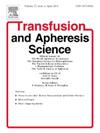静脉注射免疫球蛋白治疗母体血小板减少后血小板计数反应的预测因素
IF 1.4
4区 医学
Q4 HEMATOLOGY
引用次数: 0
摘要
背景:妊娠期血小板减少可能需要静脉注射免疫球蛋白(IVIG),特别是当怀疑有免疫性血小板减少时。然而,IVIG的有效性并不明确,这在最佳治疗策略上造成了差距。本研究旨在评估IVIG对中重度血小板减少孕妇的疗效,并确定血小板反应的预测因素,旨在优化临床决策和资源利用。方法对2007年至2020年间接受IVIG治疗的79例中重度血小板减少症(血小板[PLT] & 100 ×109/L)孕妇进行单中心回顾性队列研究。收集了产妇人口统计学、血小板计数、未成熟血小板分数(IPF)和IVIG给药的数据。Logistic回归确定了IVIG治疗后PLT≥ 80 × 109/L和增量≥ 20 × 109/L的预测因子。ResultsThe值增量PLT丙种球蛋白后响应政府16 × 109 / L,实现PLT≥49.4 % 80 × 109 / L和46.8 %实现增量≥20 × 109 / L。有利反应的预测因子包括最低点PLT <; 30 × 109/L (OR = 6.29), IPF <; 16 % (OR = 4.85)和ivig前PLT <; 50 × 109/L (OR = 8.67)。较高的ivig前PLT计数(70-100 ×109/L)与较低的实现显著PLT增加的几率相关。ivig可有效增加重度血小板减少孕妇的PLT计数,特别是那些PLT <; 30 × 109/L, IPF <; 16 %,或ivig前PLT <; 50 × 109/L的孕妇。这项研究强调了在IVIG中谨慎选择患者以提高疗效和节约资源的重要性。未来的研究应侧重于前瞻性研究,以完善母体血小板减少的IVIG治疗指南和资源管理。本文章由计算机程序翻译,如有差异,请以英文原文为准。
Predictors of platelet count response following intravenous immunoglobulin use for maternal thrombocytopenia
Background
Thrombocytopenia in pregnancy may require administering intravenous immunoglobulin (IVIG), particularly when immune thrombocytopenia is suspected. However, the effectiveness of IVIG is not well-defined, creating a gap in optimal treatment strategies. This study aims to evaluate the efficacy of IVIG and identify predictors of platelet response in pregnant persons with moderate-to-severe thrombocytopenia, aiming to optimize clinical decisions and resource use.
Methods
We conducted a single-center retrospective cohort study of 79 pregnant persons with moderate-to-severe thrombocytopenia (platelets [PLT] <100 ×109/L) who received IVIG between 2007 and 2020. Data on maternal demographics, PLT counts, immature platelet fraction (IPF), and IVIG administration were collected. Logistic regression identified predictors of achieving a PLT ≥ 80 × 109/L and an increment ≥ 20 × 109/L following IVIG administration.
Results
The median incremental PLT response following IVIG administration was 16 × 109/L, with 49.4 % achieving PLT ≥ 80 × 109/L and 46.8 % achieving an increment ≥ 20 × 109/L. Predictors of a favorable response included nadir PLT < 30 × 109/L (OR = 6.29), IPF < 16 % (OR = 4.85), and pre-IVIG PLT < 50 × 109/L (OR = 8.67). Higher pre-IVIG PLT counts (70–100 ×109/L) were associated with lower odds of achieving a significant PLT increment.
Discussion
IVIG effectively increases PLT counts in pregnant persons with severe thrombocytopenia, especially in those with a nadir PLT < 30 × 109/L, IPF < 16 %, or pre-IVIG PLT < 50 × 109/L. This study highlights the importance of careful patient selection for IVIG to enhance outcomes and conserve resources. Future research should focus on prospective studies to refine treatment guidelines and resource stewardship of IVIG for maternal thrombocytopenia.
求助全文
通过发布文献求助,成功后即可免费获取论文全文。
去求助
来源期刊
CiteScore
3.60
自引率
5.30%
发文量
181
审稿时长
42 days
期刊介绍:
Transfusion and Apheresis Science brings comprehensive and up-to-date information to physicians and health care professionals involved in the rapidly changing fields of transfusion medicine, hemostasis and apheresis. The journal presents original articles relating to scientific and clinical studies in the areas of immunohematology, transfusion practice, bleeding and thrombotic disorders and both therapeutic and donor apheresis including hematopoietic stem cells. Topics covered include the collection and processing of blood, compatibility testing and guidelines for the use of blood products, as well as screening for and transmission of blood-borne diseases. All areas of apheresis - therapeutic and collection - are also addressed. We would like to specifically encourage allied health professionals in this area to submit manuscripts that relate to improved patient and donor care, technical aspects and educational issues.
Transfusion and Apheresis Science features a "Theme" section which includes, in each issue, a group of papers designed to review a specific topic of current importance in transfusion and hemostasis for the discussion of topical issues specific to apheresis and focuses on the operators'' viewpoint. Another section is "What''s Happening" which provides informal reporting of activities in the field. In addition, brief case reports and Letters to the Editor, as well as reviews of meetings and events of general interest, and a listing of recent patents make the journal a complete source of information for practitioners of transfusion, hemostasis and apheresis science. Immediate dissemination of important information is ensured by the commitment of Transfusion and Apheresis Science to rapid publication of both symposia and submitted papers.

 求助内容:
求助内容: 应助结果提醒方式:
应助结果提醒方式:


